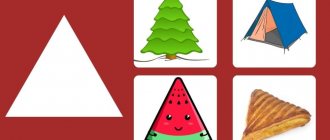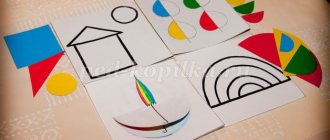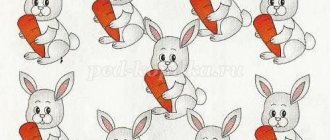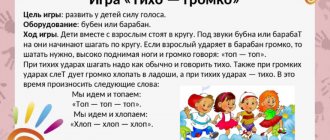Didactic game “Yesterday, today, tomorrow”
Goal: to develop children’s ability to navigate time, to consolidate the concepts of “yesterday”, “today”, “tomorrow”.
Material: multi-colored stripes, a selection of poems.
Progress of the game: the teacher explains that every day, in addition to its name, has another name (yesterday, today, tomorrow).
The day that has come is called today.
A day that has already ended is yesterday.
And the day that is yet to come is tomorrow.
We designate the colors (stripes): today – blue, yesterday – blue, tomorrow – purple.
First, we fix the color designation: the teacher names the concepts, the children show the corresponding strip.
Then the teacher reads the poem, the children determine what day the poem is about (yesterday, today, tomorrow) and show the corresponding strip.
Ball game "Yesterday, today, tomorrow"
Goal: to develop children’s ability to navigate time, to consolidate the concepts of “yesterday”, “today”, “tomorrow”.
Material: ball
Progress of the game: the teacher throws the ball to the children one by one, saying a short phrase, for example, “We are doing...” The child who caught the ball finishes the phrase (... today).
Example phrases:
We are going to walk…
Did you go to the park...
We will read a book...
Didactic game “Colorful week”
Goal: to consolidate ideas about the days of the week, to consolidate the names and sequence of the days of the week, to develop navigation skills in the days of the week.
Material: multi-colored circles, numbers from 1 to 7.
Progress of the game: the teacher on the demonstration circle indicates the color and names the day of the week, the children show the corresponding number.
Option 1: the teacher shows the numbers from 1 to 7 in order, the children show the corresponding color on their circles and name the day of the week.
Didactic game “Week, line up”
Goal: to consolidate ideas about the days of the week, to consolidate the names and sequence of the days of the week, to develop navigation skills in the days of the week.
Material: numbers 1-7.
How to play: There are upside-down cards with numbers on the table. Children take cards from the table at a signal. They look for their partners, that is, they line up in order and name their day of the week (“The first is Monday, the second is Tuesday...).
Tasks:
1. The teacher asks to leave the day that represents Monday;... Wednesday, etc.
2. The teacher asks for the day of the week that comes after Monday, before Saturday, between Tuesday and Thursday, etc.
3. The teacher asks to come out the days of the week that are after Thursday (children with the numbers five, six, seven come out); before Wednesday (children with numbers one, two) and name their days of the week.
Ball game “Catch, throw, name the days of the week”
Goal: to consolidate ideas about the days of the week, to consolidate the names and sequence of the days of the week, to develop navigation skills in the days of the week.
Material: ball.
Progress of the game: children form a circle. The teacher stands in the middle of the circle. He throws a ball to one of the children and says: “What day of the week is today?” The child who caught the ball answers: “Tuesday.” Then the teacher throws the ball to another child and asks a question like: “What day of the week was yesterday?”
Question options:
Name the day of the week after Thursday. Name the day of the week between Thursday and Friday, etc.
If someone finds it difficult to quickly give an answer, the teacher invites the children to help him.
Ball game “It happens - it doesn’t happen”
Goal: to develop verbal and logical thinking, to consolidate ideas about the signs of the seasons.
Material: ball.
Progress of the game: the players stand in a circle. The teacher names a sign of a certain time of year. The child catches the ball if this sign is appropriate.
Exercise “Repeat, don’t make a mistake”
Goal: to consolidate the names of the months (according to the seasons).
Progress of the game: the child names the names of the autumn (winter, spring...) months in order, with or without pictures.
Ball game "Carry on"
Goal : develop time orientation skills, consolidate the ability to name the signs of the seasons.
Material: ball
Progress of the game: children and the teacher stand in a circle, the teacher names the season and gives the ball to the child, the children name the signs of this season and pass the ball around the circle.
Preparatory group
For preschoolers aged 6-7 years, more complex educational games are provided that develop logic and thinking abilities.
Hide and seek
Tell the students that the days of the week wanted to play hide and seek. But there is a hint that allows you to quickly find them. Each of them hid behind an object or in a room whose name begins with the same letter as the day. Name this object, and the children must guess the day.
For example:
- hid behind the desk... Monday;
- behind the hanger... Tuesday;
- behind the bench... Wednesday;
- in the attic... Thursday;
- in the hallway... Friday;
- behind the chair... Saturday;
- in the bathroom... Sunday.
Say the word
To play you need a ball. Throw it to the players one by one, asking questions like this:
- on Monday mom works, and on Sunday... she rests;
- Wednesday is followed by... Thursday;
- Tuesday is today, and Wednesday is... tomorrow;
- Today is Friday, and yesterday was... Thursday.
Formation of concepts in children 4-5 years old - week, days of the week
Experience in “Formation of concepts in middle preschool children - week, days of the week”
My material will be of interest to teachers of middle preschool groups, students and interested parents Goal : To form in children temporary concepts of “week”, “days of the week”; why the week and its days received such names; fix the sequence of days of the week and the serial number of the day; learn to correlate the day of the week and the symbol - color, number. A child’s readiness for school , in addition to intellectual readiness, includes important components: good physical health, the ability to communicate with children and adults, high cognitive activity, the ability to perceive the world around him and adapt to new social conditions, independence, and the ability to plan one’s activities. , spatiotemporal orientation. It is vital for preschoolers to learn how to navigate time themselves: to determine, measure time, correctly denoting it in speech, to feel its duration in order to regulate and plan activities, changing their actions depending on the availability of time. We introduce children to the world around them, in which all events and changes in phenomena occur in time. The temporal characteristics of the unfolding of real phenomena, their duration, the order in which they follow each other, the speed of occurrence, the frequency of repetitions and rhythm must be shown and explained to preschool children. Time is perceived by the child directly, through the concretization of temporary units and relationships in constantly recurring phenomena of life and activity. Children's ideas about such periods of time and their discrimination skills, which are formed on the basis of personal experience, are more accurate. Therefore, children need to be introduced to such time intervals that can be used to measure and determine the duration, sequence, and rhythm of their actions and various types of activities. From the age of 4 you can start learning about the days of the week. It will not be easy for a child to remember the days of the week, but teachers must approach this issue creatively. At the very beginning of my work, I tested children in order to find out what children knew about the days of the week and asked the following questions: “What days of the week do you know? What day of the week is it today? The children's answers showed that the names of the days of the week are learned by children with difficulty and unevenly. Children know days of the week such as Sunday, Saturday, Friday, Monday better than Tuesday, Wednesday and Thursday. Consequently, the names of the days of the week are acquired by the child in connection with his life experience, the nature of his activities, and the emotional experiences that have arisen. Many children knew the days of the week - Monday and Friday. Other days of the week were often confused, replacing the name of one day of the week with another, or calling the month instead of the day of the week, or saying “today”, “tomorrow”, or even simply (cloudy day, sunny day). I also found out whether the children knew the sequential connection of the days of the week by asking questions: “What day of the week is today? What day of the week was yesterday? What day of the week will be tomorrow?" - it turned out that the children knew the previous, past day better than the present one. To identify an understanding of the sequence of alternating days of the week and the relationship between them in direct and reverse order, children were asked questions like: “What day is before Monday and after Monday?” Some of the children named which day would be before and after the one named, they restored in their memory a chain of words-names of the days of the week and accurately identified the previous and subsequent days. The remaining children experienced various difficulties in establishing relationships in direct and reverse order of the days of the week. Often children named the entire chain of names in a low voice and, having reached the indicated day, called the next day loudly. At the same time, it was much more difficult for them to name the previous day. The test results showed that asking the question about the day of the week itself causes difficulty for children. Having some specific ideas, the children found it difficult to correlate them with the desired concept. Children's knowledge about time periods is inaccurate and not systematized. I concluded that I, as a teacher, need to structure my work in such a way as to help students consolidate their knowledge on this topic. I organize my work as follows. First, I form ideas about weekends, then about the first and last days of the week, then about Tuesday, Wednesday and Thursday. Only after this we build a model of the week with the guys. In the process of forming ideas about the days of the week, I draw on the personal experience of children’s lives and activities, paying attention to what days there are musical, theatrical activities, physical education, etc. I use various visual materials: - A seven-flowered flower whose petals “come off” with each subsequent day of the week; - a circle divided into 7 multi-colored parts with an arrow in the middle; (children’s ideas about the days of the week can be associated with ordinal numbers, and each day of the week can be designated by a number, attached to parts of the circle every day from Monday to Friday. On Friday you can add Saturday (“What day of the week will it be tomorrow?”), and (“What day week will be the day after tomorrow?) (“What day of the week was yesterday?”) Every morning we remember with the children: “Today is the first day of the week - Monday. Let’s attach the number 1.” “What day of the week is it today? What is Monday?”; children can ask questions: “Why is this day called Tuesday?”, “What day comes after Tuesday?” “Which day is Wednesday in order?” “What is the name of the fourth day of the week?”, “How many days are there in the week?”, etc. d. To repeat and consolidate ideas about the days of the week, I use a variety of didactic games, such as: “Catching the days of the week”, “Catch, throw, name the days of the week” (with a ball), “What should be why?”, “What should be why? ”, “Listen and remember”, “Weekend-weekdays”, “Be attentive!”; Literary works: learning children's poems on the theme of E. Stekvashov “Week”, A Usachev “Seven days of the week”, Yu Moritz “Where did Monday go, physical minutes. Increased the level of pedagogical culture of parents; pedagogical education of parents; strengthened cooperation with the family, consultations for parents were collected. “Why you need to learn the days of the week”, “We teach the days of the week easily and with pleasure”, “We teach the days of the week.” I introduced parents to didactic and role-playing games, outdoor games that contribute to the development of children’s time concepts - the week, the days of the week. Work experience shows that children have knowledge about the “week”, “days of the week”; children learned why the week and its days received such names; The sequence of days of the week and the serial number of the day were fixed, children learned to correlate the day of the week and the symbol - color, number. I am sure that in the future, it will be much easier for my kids to acquire knowledge about time concepts - month, seasons, etc. The visual material I use when working on this topic. - A seven-flowered flower whose petals “come off” with each subsequent day of the week. Each color corresponds to a specific day: Red - Monday, orange - Tuesday, yellow - Wednesday, green - Thursday, blue - Friday, blue - Saturday, purple - Sunday.
— A circle divided into 7 multi-colored parts with an arrow in the middle; (children’s ideas about the days of the week can be associated with ordinal numbers, and each day of the week can be designated by a number.
-Pictures with an “image” of each day of the week and poems for them.
We recommend watching:
Familiarization of preschoolers 5-7 years old with nature in kindergarten Experience of working as a kindergarten teacher. Educational innovations Kinesiology in kindergarten Experience as a preschool teacher. Paper crafts to prepare preschoolers for writing
Similar articles:
From work experience. Nurturing a culture of verbal communication in preschoolers
GCD in the senior group. Getting to know the days of the week
Direct educational activity “Introducing children of senior preschool age to the days of the week.”
Objectives: To introduce children to the names and the sequence of days of the week. Fix the names and sequence of days of the week in children’s active speech. Teach children to visually lay out the days of the week in a certain sequence. Continue teaching ordinal counting. Develop attention, memory, thinking. Continue teaching children to name the colors of the spectrum. Equipment : Demonstrative material: “Grid-week”, cards with numbers (from 1 to 7), colored cards (K, O, F, Z, G, S, F); the same handout depending on the number of children present.
Progress of the lesson:
A week grid hangs on the board. • What's on the board? How do you think? • Let's count the LINES? How many are there? (7) • Does this number tell you anything? • Let's remember our favorite fairy tales, in which fairy tales does the number 7 appear? (7 KIDS, SEVEN-FLOWER FLOWER, SNOW WHITE AND THE SEVEN Dwarfs) • Where in life can we meet the number 7? (7 WONDERS OF THE WORLD, 7 DAYS A WEEK, 7 COLORS OF THE RAINBOW) Guess the riddle: THERE ARE EXACTLY SEVEN THESE BROTHERS. YOU ALL KNOW THEM. EVERY WEEK THE BROTHERS WALK AROUND EACH OTHER, THE LAST ONE GOES AWAY - THE ONE IN FRONT APPEARS. (DAYS OF THE WEEK) • maybe someone knows the name of each of the brothers? (Mon, Tue, Wed….) Now let’s get back to our grid. These guys are not just a grid, but a weekly grid, it will help us remember the days of the week. • Why do you think we need to know the days of the week? (in order to know when it’s a day off and not to come to kindergarten, to know when and what day of classes, we go to music classes on Mon and Wed, that is, on certain days) • Haven’t you thought why ours are those brothers names? But because (SHOW THE NAMES ON YOUR HAND and at the same time fill the grid in order with numbers) MONDAY is the first after the week, after the weekend. TUESDAY - second, WEDNESDAY - who knows why? BECAUSE HE'S IN THE MIDDLE! FRIDAY, SATURDAY AND SUNDAY – ON THE OTHER HAND BECAUSE THEY ARE WEEKENDS!! • Guys, now let’s fill out our “WEEK”, and each, every day we will designate with a color: MON – RED TUE – ORANGE WE – YELLOW Thu – GREEN FRI – BLUE SAT – BLUE SUN – PURPLE • Well, what a beautiful WEEK we have? • Is there something missing here? Well, of course, who can tell me what classes we have……………..? (mark with symbols the activities that should be) Physical exercise: On Monday we did the laundry, On Tuesday we swept the floor, On Wednesday we baked kalach, We played ball all Thursday, On Friday we washed cups, And on Saturday we bought cake And of course on Sunday Invited everyone to the birthday party, sang, jumped, danced, counted the days of the week! Reflection. And now everyone has their own WEEK on their tables! you need to fill in the empty cells just like we did on the board. Don't forget that each day has its own serial number and its own assigned color!
We recommend watching:
GCD summary for the perception of music in the senior group of kindergarten GCD for children of the senior group: Culture and traditions of the Mordovian people GCD summary for drawing in the senior group on the topic: Winter Model of a program for introducing older preschoolers to the works of Konashevich
Similar articles:
Lesson in the senior group of kindergarten on the topic of February 23
Lesson notes for children of senior preschool age. Topic: Invisible air
Summary of organized educational activities for children of the senior group
Notes for mathematics classes in the senior group
Lesson summary on the topic “Reserve” in the senior group










